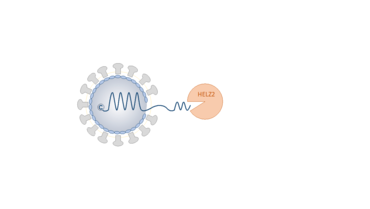A new defence protein comes into play in the response to infection
In humans, a viral infection induces a response to protect the body, resulting in the production of a signal molecule: interferon. Interferon induces the expression of numerous genes involved in the fight against these pathogens, including ribonucleases that degrade viral RNAs and/or cellular RNAs. In a study published in Nucleic Acids Research, Bertrand Séraphin and his team characterise a new ribonuclease induced by the interferon response and demonstrate that its synthesis uses an unconventional mechanism.

Following a viral infection, such as that produced by SARS-Cov2, the cells synthesise small signalling proteins called interferons, which induce profound changes in the infected cells and neighbouring cells in order to stimulate defence mechanisms and block the spread of the virus. In this way, hundreds of genes are activated to interfere with the production of new viral particles. The functions of a large proportion of the proteins induced are still unknown. Among these, ribonucleases play a key role in eliminating viral RNA and/or enabling cells to adopt a defensive programme.
In this study, the scientists determine the biochemical functions of a protein induced by interferon: HELZ2. Contrary to what the sequences deposited in the databases suggested, the scientists show that the synthesis of HELZ2 begins with an unconventional GUG translation initiation codon, which changes the protein produced. This protein is very large, 2947 amino acids, with several functional domains suggesting interactions with RNA. However, as the nuclease domain of HELZ2 diverges from the consensus, the community thought that it was inactive. Contrary to this prediction, the scientists demonstrated that HELZ2 is a ribonuclease that degrades its substrates from their 3' to their 5' ends. The presence of two helicase domains, in concert with the ribonuclease domain, enables the degradation of structured RNAs typically found in viral genomes.
All these results point to the presence of an additional ribonuclease in the defence arsenal deployed by human cells in response to viral infections. Identifying the targets of HELZ2 will enable us to gain a better understanding of its role in the response to pathogens.

The interferon response is triggered when a cell (symbolised in yellow) detects viral nucleic acids, leading to the synthesis and secretion of interferon molecules into the extracellular environment. These interferons bind to membrane receptors to activate a cell signalling pathway that enables the induction of around a hundred genes to fight the viral infection in the infected cell and neighbouring cells. This study confirms that among the genes induced by interferon (ISG genes for Interferon-Stimulated Genes, in blue on the graph) is the one coding for the HELZ2 protein (in red on the graph). The study also shows that the synthesis of this protein starts with an unconventional translation initiation codon (green arrow) located well upstream of the conventional codon (red arrow). HELZ2 contains several domains involved in nucleic acid metabolism, including a ribonuclease domain. The study revealed that HELZ2 is indeed an active nuclease and that it is capable of degrading structured RNA. The identity of its natural substrates, nucleic acids of viral or cellular origin, has yet to be determined.
Credits : Eric Huntzinger, IGBMC
